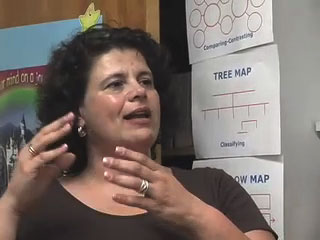



Learning Prep: Graphical Organizers
West Newton, Massachusetts
Graphic organizers help students read better by making reading "an active process in which they can build a bridge between prior knowledge and new information" (Kirylo and Millet, 2000, 180). According to Kirylo and Millet, activating prior knowledge is critical to the success of obtaining meaning from the text. .. . Learners relate new knowledge to what they already know, thus assimilating the new information. The construction of graphic organizers encourages the organization of ideas, words, and concepts, assists in making meaningful patterns and connections, and facilitates comprehension and retention of new text. (2000, 182-1 83) Spatial formats are a successful strategy that facilitate the integration of scaffolding with visuals in order that information may be sorted and broken down into manageable pieces, thus enabling it to be processed by passive learners. Such visual tools clearly portray connections between main categories and sub-categories that textbooks fail to establish explicitly. Or, by completing a graphic organizer as a pre-reading exercise, the teacher can assist the student in retrieving prior knowledge that is critical in establishing the connection between prior knowledge and new concepts. Students are likewise introduced to the reading material in a manner that develops interactive and interpersonal skills (DiCecco and Gleason, 2002, 306).

An interview with a Learning Prep parent about her daughter's real life use of Thinking Maps in a critical medical situation.
![]() Watch the video clip in Quicktime (5:22)
Watch the video clip in Quicktime (5:22)
Research has proven that students retain and retrieve information better when a graphic organizer, rather than an outline, is used, since a graphic organizer is deposited in one's memory much like a picture is stored (Katayama and Robinson, 2000, 120). Kulhavy, Lee, and Caterino have found that "storing text information in both spatial and verbal formats.. . provide[s] the student with an additional retrieval path for recalling the information ... . Two routes are better than one" (Katayama and Robinson, 2000, 120). For students who do not fill out a graphic organizer with useful or thorough information, an option is for the teacher to pass out a partiallyconstructed graphic organizer. The students know precisely what is expected of them, yet they benefit from constructing the organizer themselves (Katayama and Robinson, 2000, 123).
One needs to understand the importance of using graphic organizers before attempting to use them in the classroom. They "communicate both vertical, hierarchical concept relations.. . and horizontal, coordinate concept relations.. . that are essential for successful content application to occur" (Robinson, Katayama, DuBois, and Devaney, 1998, p. 17). Winn found that "students may extract more information from a quick glance at a spatial display than they can from a longer viewing of a linear display," such as an outline or general chapter notes; it was also discovered that students "found information needed to answer questions faster than when they searched out1 ines or texts" (Robinson, Katayama, DuBois, and Devaney, 1998, p. 18 and 21). Graphic organizers "facilitate learning of concept relations.. . in an efficient, spatial format that can be easily searched for information.. . like [an organized] library.. . [instead of] one where books are randomly stacked in piles" (Robinson, Katayama, DuBois, and Devaney, 1998, p. 21).
Download the Improving Reading Comprehension Through Visual Tools Thesis by Cynthia Manning
- Thesis Summary (pdf file)
- Complete Thesis (pdf file)